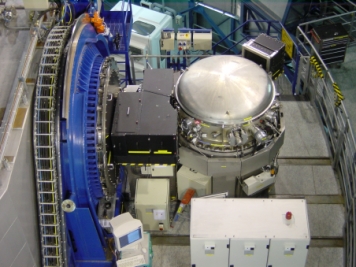CRIRES - CRyogenic high-resolution InfraRed Echelle Spectrograph
Summary

Note that CRIRES was removed from UT1 in July 2014 for an upgrade and not be offered from P94 onwards. CRIRES will be installed and commissioned on the UT3 Nasmyth B focus in Period 104 and Period 105. Depending on the results of the commissioning, CRIRES will be offered for Period 107. Before then there will be science verification. See the CRIRES plus website for the most up to date information.
CRIRES plus is described on the following webpage
The VLT cryogenic high-resolution infrared echelle spectrograph CRIRES is located at the Nasmyth focus A of UT1 (Antu). It provides are solving power of up to 105 in the spectral range from 1 to 5.3μm when used with a 0."2 arcsec slit. CRIRES can boost all scientific applications aiming at fainter objects, higher spatial(extended sources), spectral and temporal resolution. Simultaneous spectral coverage is maximized through a mosaic of four Aladdin IIIInSb arrays providing an effective 4096 x 512 focal plane detector array in the focal plane. Adaptive Optics (MACAO - Multi-Applications Curvature Adaptive optics) is used to optimize the signal-to-noise ratio and the spatial resolution.
Publications based on data obtained with the CRIRES instrument should quote the following reference paper: Käufl, H.U. et al. 2004, SPIE, 5492, 1218 .
Contact Information
- Questions related to service mode observations and proposal preparation should be addressed to the User Support Department.
- Questions related to visitor mode observations should be addressed to Paranal Science Operations
- Please send us your comments, suggestions and report errors and inaccurate statements in the web pages and manuals.
Content of these pages
The following items are available on all the CRIRES pages, using the bar on the left.
- Overview: a short description of the instrument
- News: list of changes affecting the instrument and/or its pages.
- Instrument Description: all the important parameters of the instrument.
- Manuals: links to all the documents related to CRIRES.
- Tools: a collection of useful tools and informations for preparing and analyzing the CRIRES observations.
- Instrument Operations Team
- Visitor Instructions: Instrument specific instructions for Visiting Astronomers
- Science: Science done with CRIRES, incl. during Science Verification
